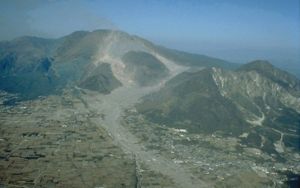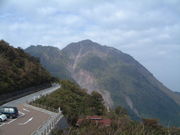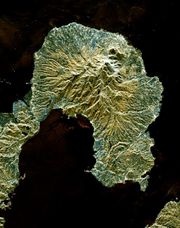Mount Unzen
2008/9 Schools Wikipedia Selection. Related subjects: Geography of Asia
| Mount Unzen | |
|---|---|
 Mt. Unzen, showing extensive pyroclastic flow and lahar deposits |
|
| Elevation | 1,500 m (4,921 ft) |
| Location | Kyūshū, Japan |
| Coordinates | |
| Type | Complex stratovolcano |
| Age of rock | Oldest 500 Kyr |
| Last eruption | 1996 |
Mount Unzen ( jp: 雲仙岳 Unzendake) is an active volcanic complex of several overlapping stratovolcanoes near the city of Shimabara, Nagasaki Prefecture, on the island of Kyūshū, Japan’s southernmost main island.
In 1792, the collapse of one of its several lava domes triggered a tsunami that killed about 15,000 people in Japan’s worst-ever volcanic disaster. The volcano was most recently active from 1990 to 1995, and a large eruption in 1991 generated a pyroclastic flow that killed 44 people, including three volcanologists.
Currently its highest peaks are Fugendake (普賢岳) at 1,359 meters and Heisei Shinzan (平成新山) at 1,486 meters. The latter emerged during the eruptions of the early, eponymous Heisei era (1989–).
Eruptive history
To 1989
Mount Unzen forms part of the Shimabara Peninsula, which has seen extensive volcanism over thousands of years. The oldest volcanic deposits in the region date from over 6 million years ago, and extensive eruptions occurred over the whole peninsula between 2.5 and 0.5 million years ago.
The origins of the Unzen complex are traced to the formation of a graben through crustal faulting. This caused parts of the peninsula to subside by up to 1,000 m below sea level and may have caused eruptive activity to localize at one site inside the graben. Eruptions of dacitic lava began from a site slightly to the south of today’s Mount Unzen and migrated north over time.
The volcano grew rapidly during its first 200,000 years, forming a large cone. Later eruptions over the following 150,000 years filled in much of the graben. Initially, activity was dominated by blocky andesitic lava and ash flows, changing to dacitic pumice flows and airfall deposits from 500,000 to 400,000 years ago. The period from 400,000 to 300,000 years ago saw the emplacement of large areas of pyroclastic flow and lahar deposits; these form the major part of the volcanic fan surrounding the volcano. Beginning 300,000 to 150,000 years ago, thick phreatomagmatic deposits were laid down, suggesting the subsidence of the volcano into its graben was rapid during this period.
Activity from 150,000 years ago to the present has occurred at a number of sites around the volcanic complex, building four main domes at different times: the Nodake (70-150,000 years old), Myokendake (25-40,000 years old), Fugendake (younger than 25,000 years old) and Mayuyama (4,000 years old) volcanic peaks. Fugendake has been the site of most eruptions during the past 20,000 years and lies about 6 km of the centre of Shimabara.
Unzen’s deadliest eruption occurred in 1792, with a large dacitic lava flow coming from Fugendake. The east flank of the Mayuyama dome collapsed unexpectedly following a post-eruption earthquake, creating an avalanche and tsunami that injured an estimated 15,000 people. This remains Japan’s worst-ever volcanic disaster.
In the 17th Century, the Japanese government used Fumie to reveal practicing Catholics and sympathizers. Fumie were pictures of the Virgin Mary and Christ. Government officials made everybody trample on these pictures. People reluctant to step on the pictures were identified as Catholics and then sent to Nagasaki. The policy of the Japanese government (Edo) was to turn them from their faith, Catholicism. However, if the Catholics refused to change their religion, they were tortured. But since many of them still refused to abandon their faith, they were killed by the government. Execution took place at Nagasaki's Mount Unzen, where many were dumped into the volcano
1990–1995
After 1792, the volcano remained dormant until an earthquake swarm began about 20 km underneath and 10 km west of Fugendake in November 1989. Over the following year, earthquakes continued, their hypocentres gradually migrating towards the summit. The first phreatic eruptions began in November 1990, and after inflation of the summit area, fresh lava began to emerge on May 20, 1991.
The threat of further, disastrous events prompted authorities to evacuate 12,000 local residents from their homes. On June 3, 1991, the volcano erupted violently, possibly as a result of depressurization of the magma column after a landslide in the crater. A pyroclastic flow reached 4.5 km from the crater and claimed the lives of 43 scientists and journalists, including volcanologists Katia and Maurice Krafft and Harry Glicken.
Between 1991 and 1994 the volcano generated at least 10,000 small pyroclastic flows, destroying about 2,000 houses. From 1993 onward, the rate of lava effusion gradually decreased, and eruptions came to an end in 1995. Since then heavy rains have frequently remobilised pyroclastic material, generating lahars. Dikes have been constructed in several river valleys to channel lahar flows away from vulnerable areas, and warning systems and evacuation plans have been developed and deployed.
Mount Unzen was designated a Decade Volcano in 1991 as part of the United Nations’ International Decade for Natural Disaster Reduction, due to its history of violent activity and location in a densely populated area.
Unzen Scientific Drilling Project (USDP)
In 1999, an ambitious project began at Mount Unzen to drill deep inside the volcano and sample magma in the 1990–1995 eruption conduit. The project hoped to shed light on some fundamental questions in volcanology, such as why magma repeatedly travels in the same conduits despite the solidification of magma in them at the end of each eruption, and how it can lose enough gas on its ascent to erupt effusively rather than explosively.
Drilling began with test bores to assess the viability of a deep borehole. Two holes were bored, 750 m and 1,500 m deep, and cores taken from these holes were used to better determine Unzen’s eruptive history. One further 350 m-deep borehole was drilled to test the methods to be used in the final drilling project.
The main drill began in 2003, starting from the northern flank of the volcano with a 17.5 inch wide hole at an angle of 25 degrees from vertical. At greater depths, the direction of boring was tilted towards the conduit, reaching an angle of 75 degrees from vertical at a depth of 800 m. Drilling reached 1,800 m, the original target depth, without reaching the conduit, but in July 2004 at a depth of 1,995 m, the conduit was finally reached. The vertical depth below the summit was 1,500 m.
The temperature at the conduit was about 155°C, much lower than pre-drill estimations of 500°C and over. This was attributed to hydrothermal circulation accelerating the cooling of the magma over the nine years since the end of the eruption.


